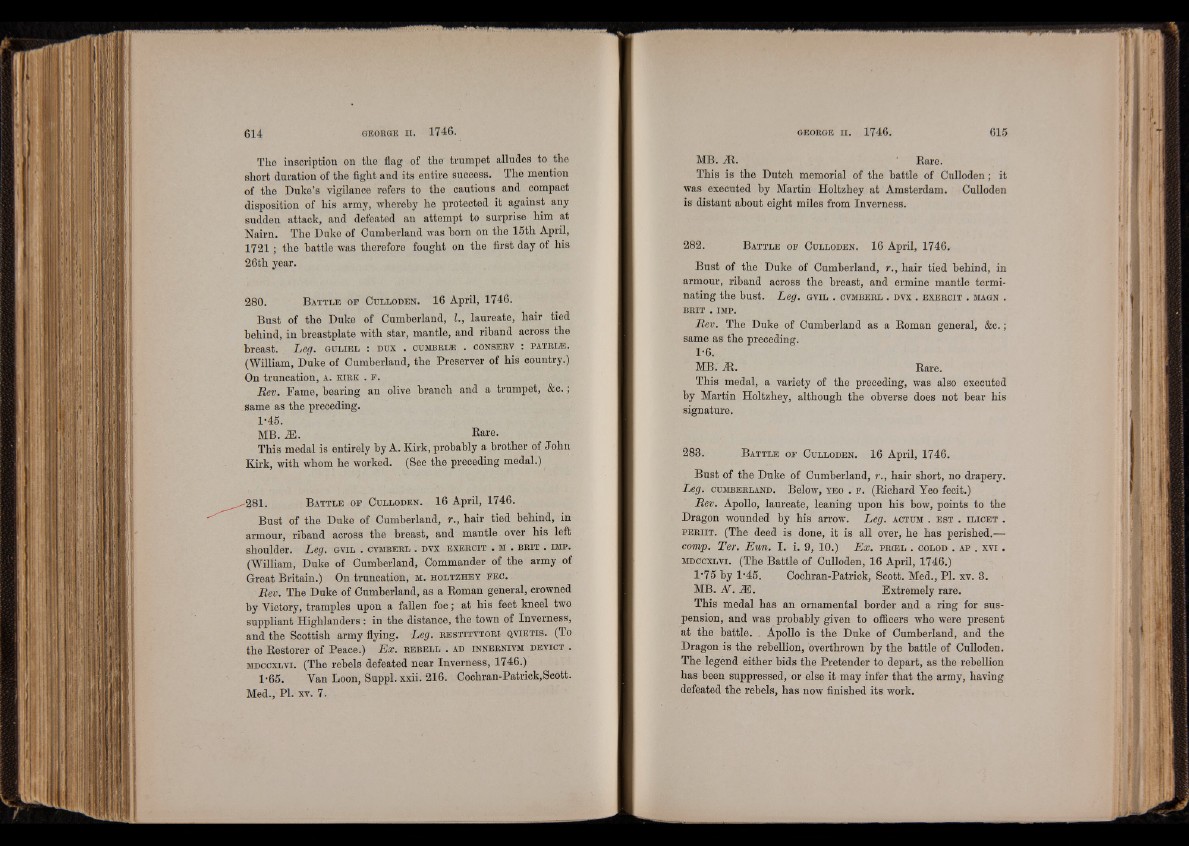
The inscription on the flag of the trumpet alludes to the
short duration of the fight and its entire success. The mention
of the Duke’s vigilance refers to the cautious and compact
disposition of his army, whereby he protected it against any
sudden attack, and defeated an attempt to surprise him at
Nairn. The Duke of Cumberland was born on the 15th April,
1721; the battle was therefore fought on the first day of his
26th year.
280. B a t t l e o f C u l l o d e n . 16 April, 1746.
Bust of the Duke of Cumberland, I., laureate, hair tied
behind, in breastplate with star, mantle, and riband across the
breast. Leg. g u l i e l : d u x . c u m b r i* . c o n s e r v : p a t r i .®.
(William, Duke of Cumberland, the Preserver of his country.)
On truncation, a . k ir k . f .
Rev. Fame, bearing an olive branch and a trumpet, &c.;
same as the preceding.
1-45.
MB. M . Rare.
This medal is entirely by A. Kirk, probably a brother of John
Kirk, with whom he worked. (See the preceding medal.)
-281. B a t t l e o f C u l l o d e n . 16 April, 1746.
Bust of the Duke of Cumberland, r., hair tied behind, in
armour, riband across the breast, and mantle over his left
shoulder. Leg. g v il . c v m b e r l . d v x e x e r c i t . M . b r i t . im p .
(William, Duke of Cumberland, Commander of the army of
Great Britain.) On truncation, m . h o l t z h e y f e c .
Rev. The Duke of Cumberland, as a Roman general, crowned
by Victory, tramples upon a fallen foe; at his feet kneel two
suppliant Highlanders: in the distance, the town of Inverness,
and the Scottish army flying. Leg. r e s t i t v t o r i q v i e t i s . ( T o
the Restorer of Peace.) Ex. r e b e l l . a d i n n e r n i v m d e v i o t .
m d c c x l v i . (The rebels defeated near Inverness, 1746.)
1-65. Van Loon, Suppl. xxii. 216. Cochran-Patrick,Scott.
Med., PI. xv. 7.
MB. jR. ' Rare.
This is the Dutch memorial of the battle of Culloden; it
was executed by Martin Holtzhey at Amsterdam. Culloden
is distant about eight miles from Inverness.
282. Battle of Culloden. 16 April, 1746.
Bust of the Duke of Cumberland, r., hair tied behind, in
armour, riband across the breast, and ermine mantle terminating
the bust. Leg. g v il . c v m b e r l . d v x . e x e r c i t . m a g n .
BRIT . IMP.
Rev. The Duke of Cumberland as a Roman general, &c.;
same as the preceding.
1-6.
MB. iR. Rare.
This medal, a variety of the preceding, was also executed
by Martin Holtzhey, although the obverse does not bear his
signature.
288. B a t t l e o f C u l l o d e n . 16 April, 1746.
Bust of the Duke of Cumberland, r., hair short, no drapery.
Ijeg. Cu m b e r l a n d . Below, y e o . F . (Richard Yeo fecit.)
Rev. Apollo, laureate, leaning upon his bow, points to the
Dragon wounded by his arrow. Leg. a c t u m . e s t . i l i c e t .
p e r i i t . (The deed is done, it is all over, he has perished.—
comp. Ter. Eun. I. i. 9, 10.) Ex. p r c e l . c o l o d . a p . x v i .
m d c c x l v i . (The Battle of Culloden, 16 April, 1746.)
1'75 by 1'45. Cochran-Patrick, Scott. Med., PI. xv. 3.
MB. N . M . Extremely rare.
This medal has an ornamental border and a ring for suspension,
and was probably given to officers who were present
at the battle. . Apollo is the Duke of Cumberland, and the
Dragon is the rebellion, overthrown by the battle of Culloden.
The legend either bids the Pretender to depart, as the rebellion
has been suppressed, or else it may infer that the army, having
defeated the rebels, has now finished its work.